Effects of Wax Molecular Weight Distribution and Branching on Moisture Sensitivity of Asphalt Binders
Abstract
:1. Introduction
2. Materials and Experiments
2.1. Materials
2.1.1. Asphalt
2.1.2. Additives
2.2. Experimental Method
2.2.1. BBS Test Method
2.2.2. SFE Test Method
2.3. Experimental Scheme
3. Results and Discussion
3.1. BBS Test
3.1.1. Cohesion and Adhesion POTS Analysis Based on BBS
3.1.2. Moisture Sensitivity Analysis Based on BBS
3.2. SFE Test
3.2.1. Cohesion and Adhesion Work Analysis Based on SFE
3.2.2. Moisture Sensitivity Analysis Based on SFE
3.3. Correlation between SFE and BBS
4. Conclusions
- (1)
- The addition of n-eicosane, n-triacontane, squalane and asphaltene can reduce the moisture sensitivity of the base asphalt, but not necessarily improve its moisture-induced damage-resistance performance.
- (2)
- For the cohesion POTS, regarding the cohesion and adhesion work in dry conditions, physical hardening has the greatest influence on n-eicosane, followed by n-triacontane. However, squalane and asphaltene have no obvious influence.
- (3)
- The physical hardening effect of high-wax asphalt and its model asphalt is stronger than that of the corresponding low-wax asphalt and its model asphalt, and its moisture sensitivity is weaker than that of low-wax asphalt.
- (4)
- Different molecular weight distributions and the branching of waxes will have different effects on the moisture sensibility of the asphalt binder.
Author Contributions
Funding
Institutional Review Board Statement
Informed Consent Statement
Data Availability Statement
Conflicts of Interest
List of Notations and Abbreviations
| BBS | binder bond strength |
| POTS | pull-off tensile strength |
| Adhesion POTS | POTS after moisture-induced damage |
| Cohesion POTS | POTS before moisture-induced damage |
| POTS Ratio | BBS moisture sensitivity index |
| SFE | surface free-energy |
| ER | SFE moisture sensitivity index |
| γ | surface free-energy |
| γLW | dispersion component |
| γAB | polarity component |
| γ+ | acid component |
| γ− | basic component |
| θ | contact angle |
| Gij | interfacial binding energy between two-phase materials |
| γij | interfacial energy of two-phase materials |
| γi | surface energy of substance i |
| γj | the surface energy of j |
| Gikj | interfacial binding energy of three-phase materials |
| WAA | cohesion work |
| WAG | adhesion work |
| WAWG | adhesion work in wet condition |
| DPH | abbreviation of degree of physical hardening |
| Value (1 h) | moisture sensitivity parameter values of conditioning time 1 h |
| Value (168 h) | moisture sensitivity parameter values of conditioning time 168 h |
References
- Ahmad, M.; Mannan, U.A.; Islam, M.R.; Tarefder, R.A. Chemical and mechanical changes in asphalt binder due to moisture conditioning. Road Mater. Pavement Des. 2018, 19, 1216–1229. [Google Scholar] [CrossRef]
- Cheng, Z.; Kong, F.; Zhang, X. Application of the Langmuir-type diffusion model to study moisture diffusion into asphalt films. Constr. Build. Mater. 2021, 268, 121192. [Google Scholar] [CrossRef]
- Cong, P.; Guo, X.; Ge, W. Effects of moisture on the bonding performance of asphalt-aggregate system. Constr. Build. Mater. 2021, 295, 123667. [Google Scholar] [CrossRef]
- Chen, X.; Xiao, H.; Cao, C.; Yan, C.; Ren, D.; Ai, C. Study on Moisture Diffusion Behavior in Asphalt Binder Based on Static and Dynamic Pore Water Conditions. J. Mater. Civ. Eng. 2022, 34, 04022183. [Google Scholar] [CrossRef]
- Lu, X.; Kalman, B.; Redelius, P. A new test method for determination of wax content in crude oils, residues and bitumens. Fuel 2008, 87, 1543–1551. [Google Scholar] [CrossRef]
- Ding, H.; Zhang, H.; Zheng, X.; Zhang, C. Characterisation of crystalline wax in asphalt binder by X-ray diffraction. Road Mater. Pavement Des. 2022, 23, 1–17. [Google Scholar] [CrossRef]
- Ding, H.; Hesp, S. Variable-temperature Fourier-transform infrared spectroscopy study of asphalt binders from the SHRP Materials Reference Library. Fuel 2021, 298, 120819. [Google Scholar] [CrossRef]
- Ding, H.; Hesp, S. Balancing the use of wax-based warm mix additives for improved asphalt compaction with long-term pavement performance. ACS Sustain. Chem. Eng. 2021, 9, 7298–7305. [Google Scholar] [CrossRef]
- Ding, H.; Hesp, S. Variable-temperature Fourier-transform infrared spectroscopy study of wax precipitation and melting in Canadian and Venezuelan asphalt binders. Constr. Build. Mater. 2020, 264, 120212. [Google Scholar] [CrossRef]
- Kriz, P. Glass Transition and Physical Hardening of Asphalts; University of Calgary: Calgary, AB, Canada, 2009. [Google Scholar]
- Omari, I.; Aggarwal, V.; Hesp, S. Investigation of two Warm Mix Asphalt additives. Int. J. Pavement Res. Technol. 2016, 9, 83–88. [Google Scholar] [CrossRef] [Green Version]
- Ding, H.; Qiu, Y.; Rahman, A. Low-Temperature reversible aging properties of selected asphalt binders based on thermal analysis. J. Mater. Civ. Eng. 2019, 31, 04018402. [Google Scholar] [CrossRef]
- Ding, H.; Qiu, Y.; Rahman, A. Influence of thermal history on the intermediate and low-temperature reversible aging properties of asphalt binders. Road Mater. Pavement Des. 2020, 21, 2126–2142. [Google Scholar] [CrossRef]
- Qiu, Y.; Ding, H.; Su, T. Non-isothermal low-temperature reversible aging of commercial wax-based warm mix asphalts. Int. J. Pavement Eng. 2022, 23, 514–522. [Google Scholar] [CrossRef]
- Zhang, H.; Zhang, H.; Ding, H.; Dai, J. Determining the Sustainable Component of Wax-Based Warm Mix Additives for Improving the Cracking Resistance of Asphalt Binders. ACS Sustain. Chem. Eng. 2021, 9, 15016–15026. [Google Scholar] [CrossRef]
- Ji, J.; Yao, H.; Yuan, Z.; Suo, Z.; Xu, Y.; Li, P.; You, Z. Moisture Susceptibility of Warm Mix Asphalt (WMA) with an Organic Wax Additive Based on X-Ray Computed Tomography (CT) Technology. Adv. Civ. Eng. 2019, 2019, 7101982. [Google Scholar] [CrossRef]
- Nakhaei, M.; Naderi, K.; Nasrekani, A.A.; Timm, D.H. Moisture resistance study on PE-wax and EBS-wax modified warm mix asphalt using chemical and mechanical procedures. Constr. Build. Mater. 2018, 189, 882–889. [Google Scholar] [CrossRef]
- Habal, A.; Singh, D. Moisture Damage Resistance of GTR-Modified Asphalt Binders Containing WMA Additives Using the Surface Free Energy Approach. J. Perform. Constr. Facil. 2017, 31, 04017006. [Google Scholar] [CrossRef]
- Edwards, Y.; Isacsson, U. Wax in bitumen: Part 1—Classifications and general aspects. Road Mater. Pavement Des. 2005, 6, 281–309. [Google Scholar] [CrossRef]
- Edwards, Y.; Isaacson, U. Wax in bitumen: Part II characterization and effects. Road Mater. Pavement Des. 2005, 6, 434–468. [Google Scholar] [CrossRef]
- Ding, H.; Liu, H.; Qiu, Y.; Rahman, A. Effects of crystalline wax and asphaltene on thermoreversible aging of asphalt binder. Int. J. Pavement Eng. 2021, 22, 1–10. [Google Scholar] [CrossRef]
- Ding, H.; Zhang, H.; Liu, H.; Qiu, Y. Thermoreversible aging in model asphalt binders. Constr. Build. Mater. 2021, 303, 124355. [Google Scholar] [CrossRef]
- Ding, H.; Hesp, S. Another look at the use of modulated differential scanning calorimetry to study thermoreversible aging phenomena in asphalt binders. Constr. Build. Mater. 2021, 267, 121787. [Google Scholar] [CrossRef]
- EN 12606-1; In Bitumen and Bituminous Binders—Determination of the Paraffin Wax Content—Part 1: Method by Distillation. European Standard: Pilsen, Czech Republic, 2015.
- ASTM D4124; In Standard Test Method for Separation of Asphalt into Four Fractions. ASTM: West Conshohocken, PA, USA, 2018.
- Ding, H.; Zhang, H.; Zhang, H.; Liu, D.; Qiu, Y.; Hussain, A. Separation of wax fraction in asphalt binder by an improved method and determination of its molecular structure. Fuel 2022, 322, 124081. [Google Scholar] [CrossRef]
- Ding, H.; Hesp, S. Quantification of crystalline wax in asphalt binders using variable-temperature Fourier-transform infrared spectroscopy. Fuel 2020, 277, 118220. [Google Scholar] [CrossRef]
- ASTM D4541; In Standard Test Method for Pull-Off Strength of Coatings Using Portable Adhesion Testers. ASTM: West Conshohocken, PA, USA, 2017.
- AASHTO TP91; In Standard Method of Test for Determining Asphalt Binder Bond Strength by Means of the Binder Bond Strength (BBS) Test. American Association of State and Highway Transport: Washington, DC, USA, 2013.
- Hntsberger, J.R. Surface Energy, Wetting and Adhesion. J. Adhes. 1981, 12, 3–12. [Google Scholar] [CrossRef]
- Tan, Y.; Guo, M. Using surface free energy method to study the cohesion and adhesion of asphalt mastic. Constr. Build. Mater. 2013, 47, 254–260. [Google Scholar] [CrossRef]
- Struik, L.C.E. Physical Aging in Amorphous Polymers and Other Materials; Elsevier: Amsterdam, The Netherlands, 1978. [Google Scholar]
- Huang, W.; Lv, Q.; Xiao, F. Investigation of using binder bond strength test to evaluate adhesion and self-healing properties of modified asphalt binders. Constr. Build. Mater. 2016, 113, 49–56. [Google Scholar] [CrossRef]
- Lu, X.; Redelius, P. Compositional and structural characterization of waxes isolated from bitumens. Energy Fuels 2006, 20, 653–660. [Google Scholar] [CrossRef]
- Kök, B.V.; Yilmaz, M.; Guler, M. Evaluation of high temperature performance of SBS+Gilsonite modified binder. Fuel 2011, 90, 3093–3099. [Google Scholar] [CrossRef] [Green Version]
- AASHTO T283; In Standard Method of Test for Resistance of Compacted Asphalt Mixtures to Moisture-Induced Damage. American Association of State and Highway Transport: Washington, DC, USA, 2014.


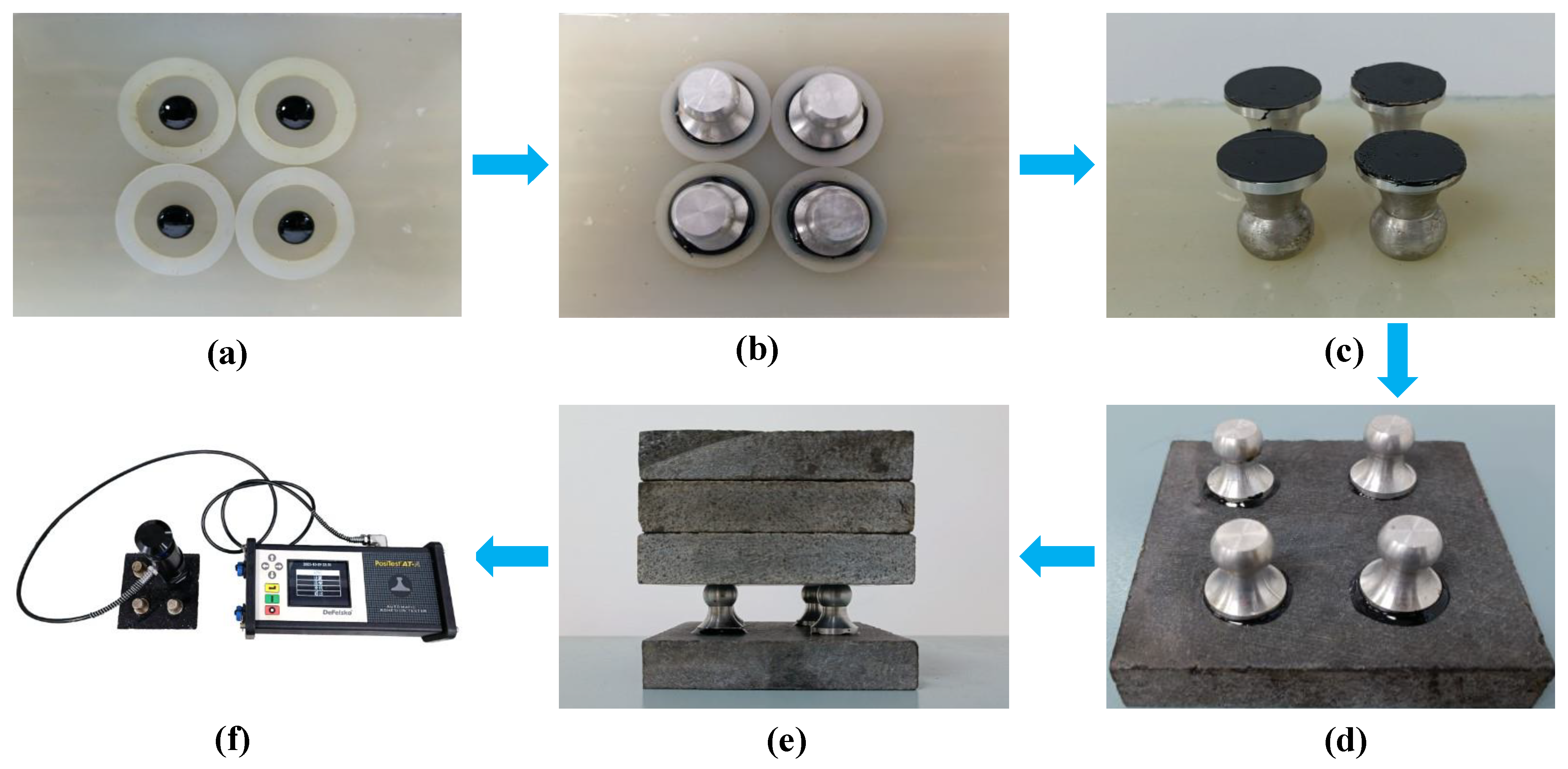
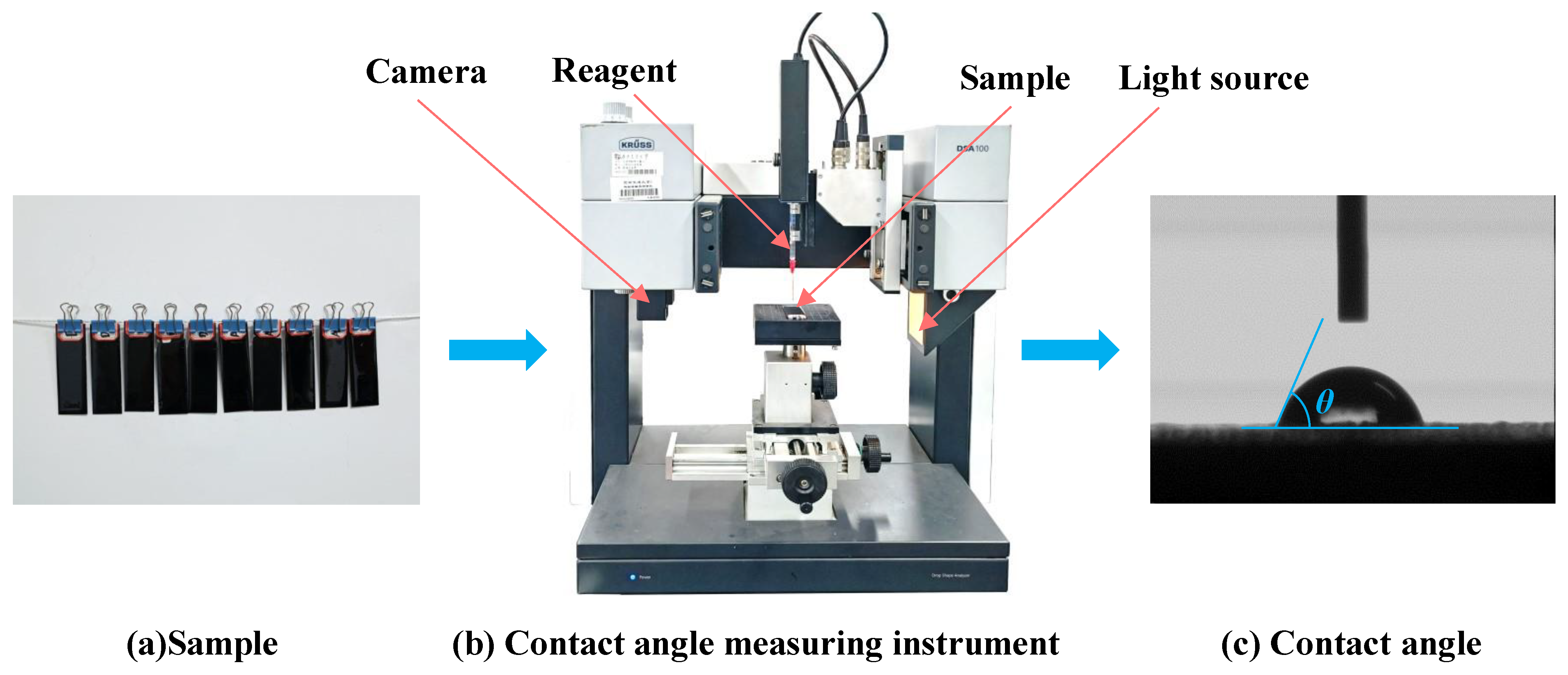
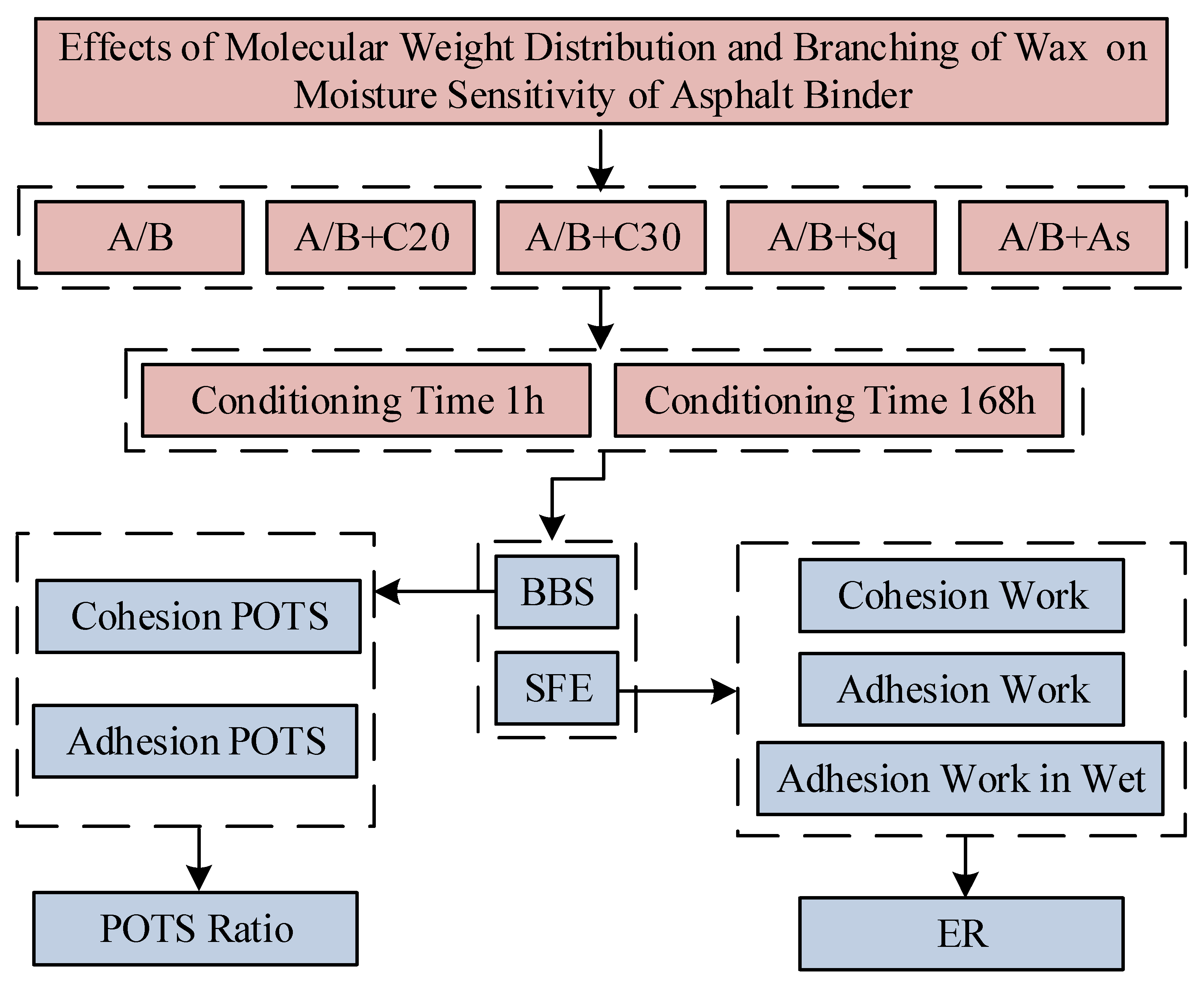
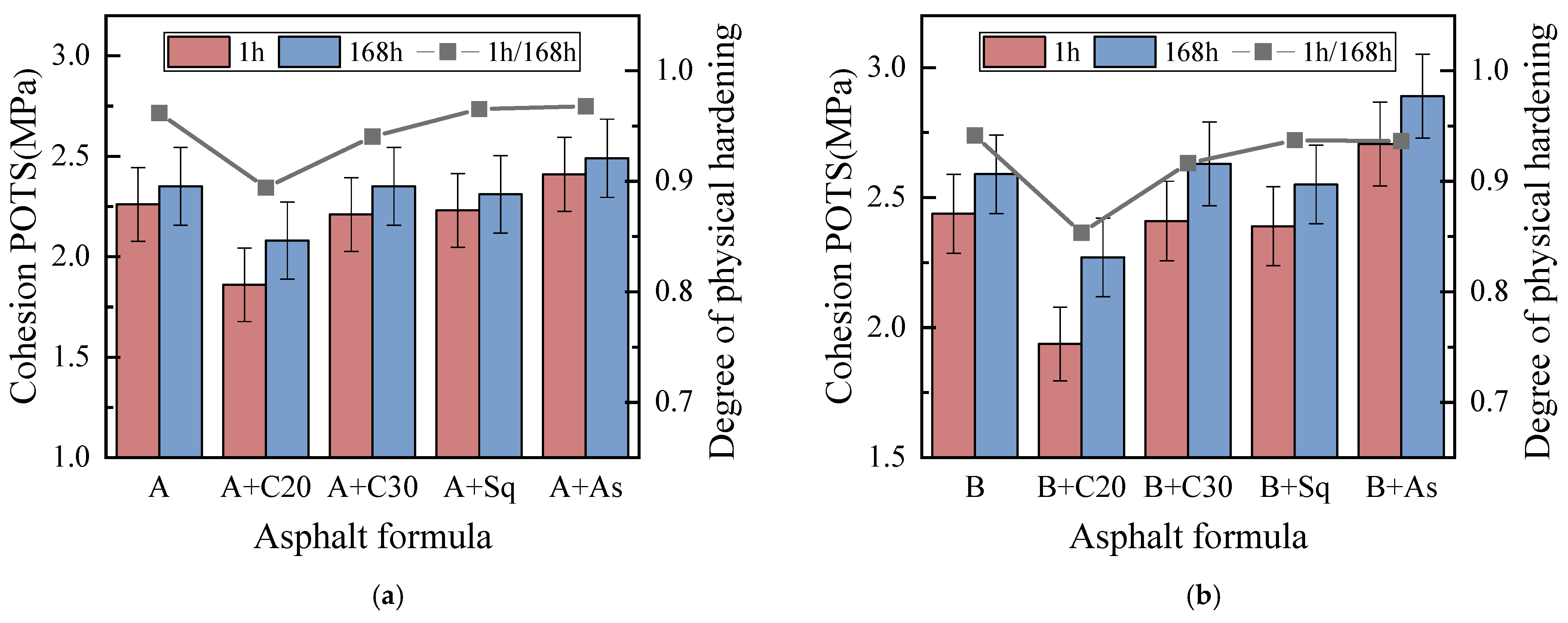

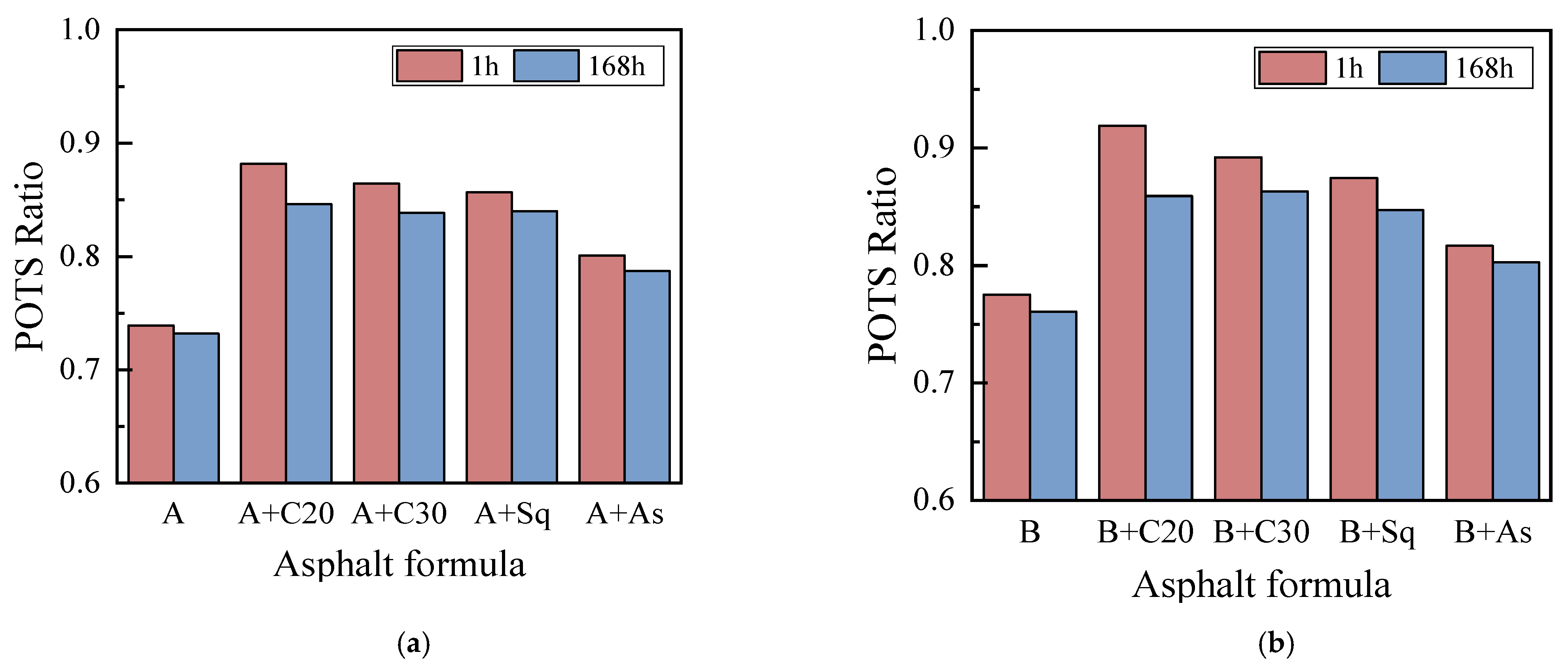
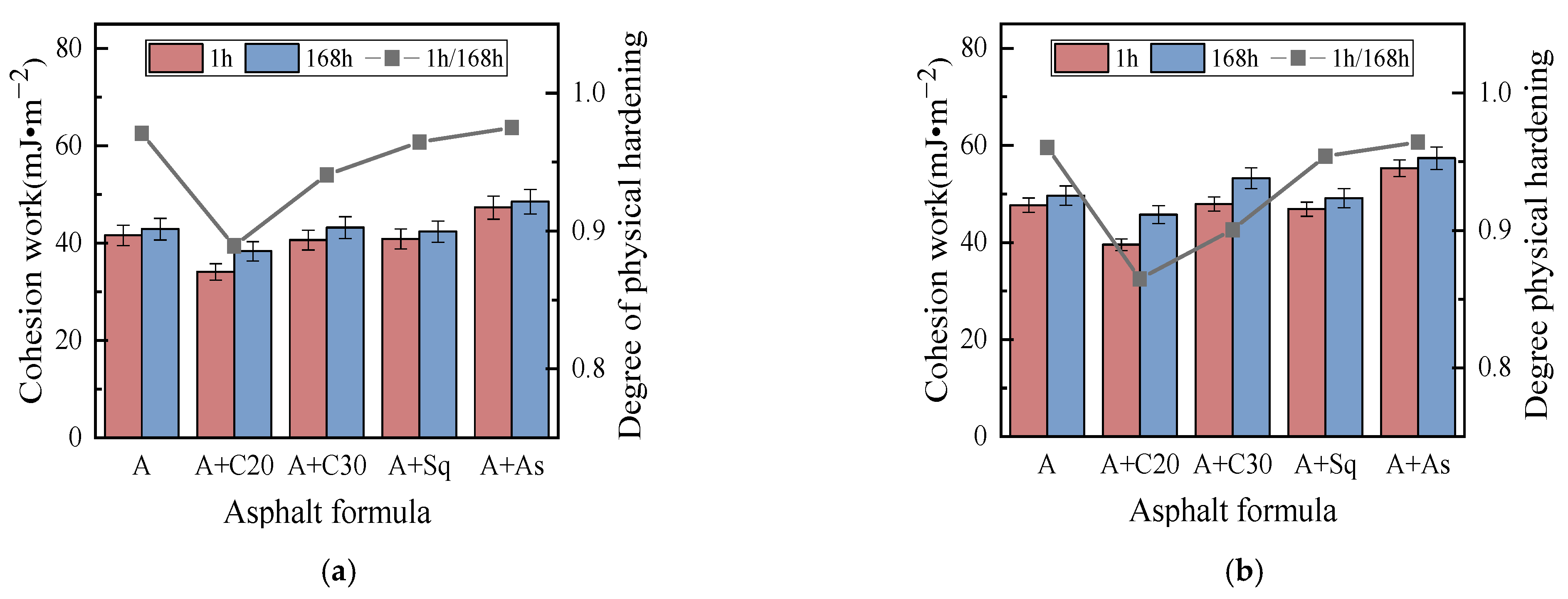

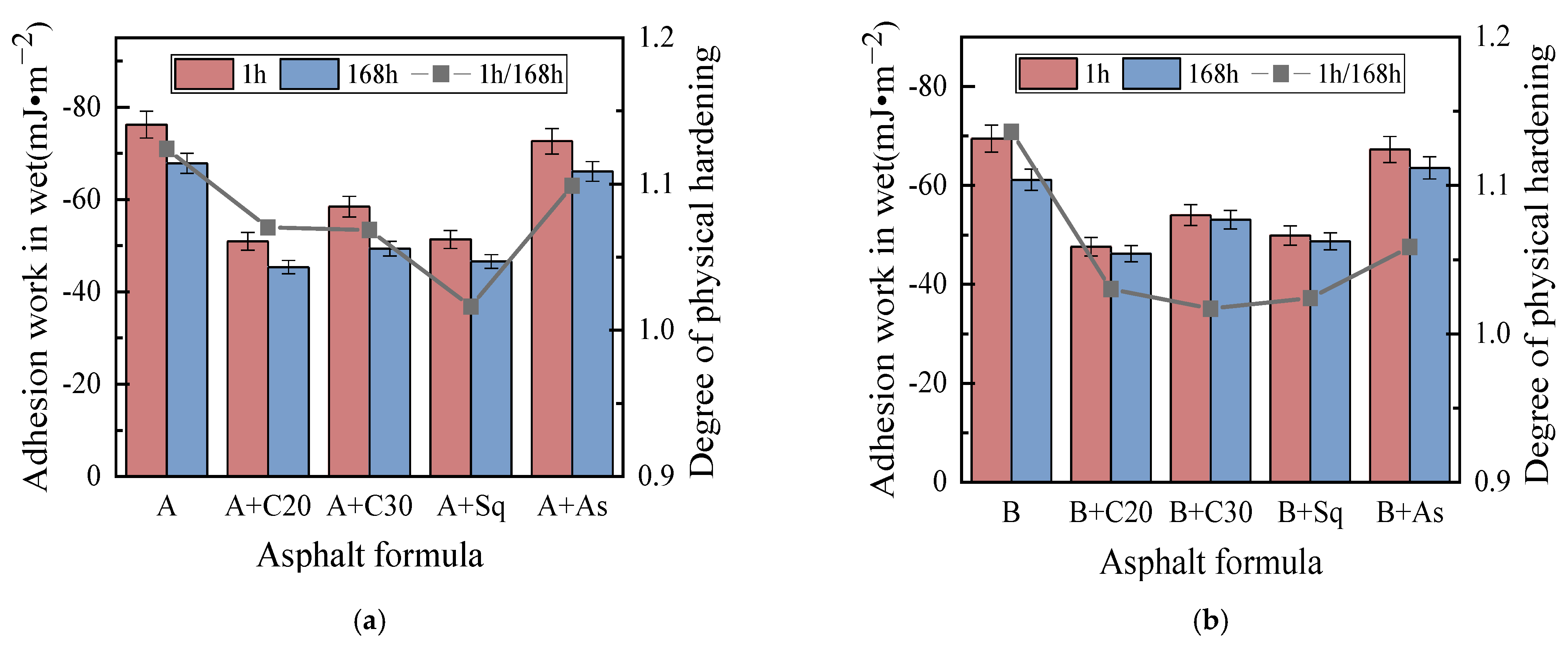
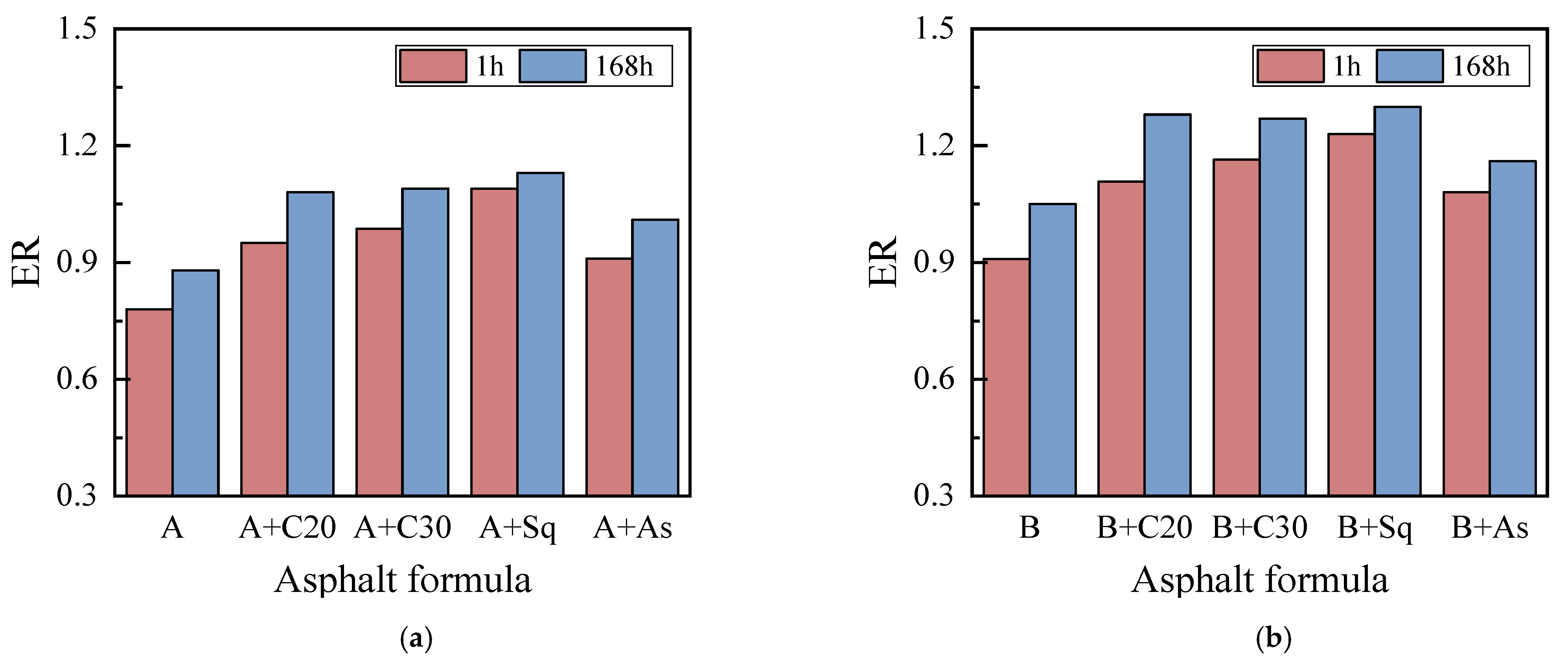
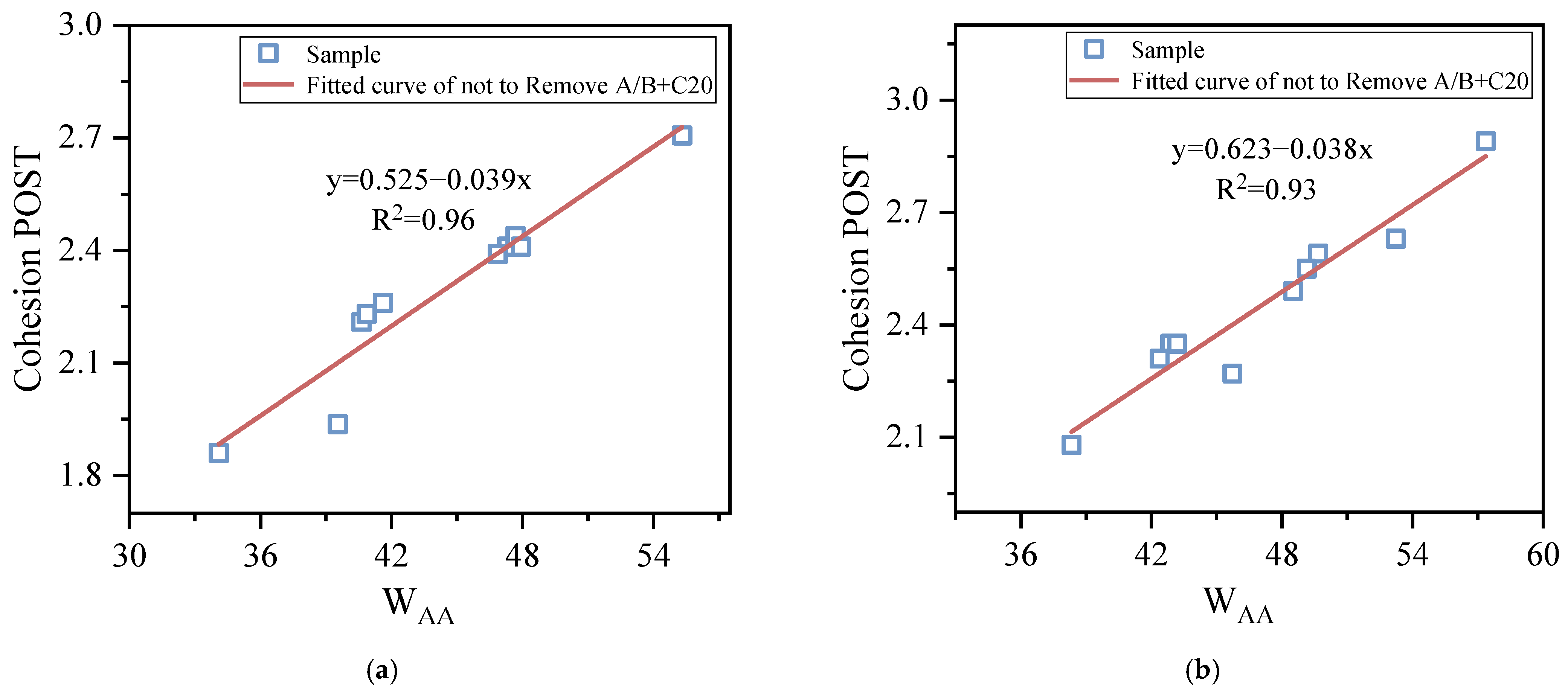

| Asphalt Sample | Penetration, 25 °C (0.1 mm) | Ductility (mm) | Soften Point (°C) | Continuous PG (°C) | Wax Content * (%) | Asphaltene Content ** (%) |
|---|---|---|---|---|---|---|
| A | 53 | 141 | 37 | 32.8–57.2 | 0.53 | 23.4 |
| B | 42 | 26 | 52 | 29.5–61.7 | 2.52 | 24.1 |
| Parameters | Abbreviation | Formula | Purity | Density | Melting Point | Appearance |
|---|---|---|---|---|---|---|
| Eicosane | C20 | C20H42 | >99.0% | 0.789 g/cm3 | 37 °C | Waxy crystals |
| Triacontane | C30 | C30H62 | >98.0% | 0.810 g/cm3 | 66 °C | Waxy crystals |
| Squalane | Sq | C30H62 | >99.0% | 0.810 g/mL | −38 °C | Colorless liquid |
| Liquids/Aggregate | γ+ | γ− | γAB | γLW | γ |
|---|---|---|---|---|---|
| Distilled water (H2O) | 25.5 | 25.5 | 51 | 21.8 | 72.8 |
| Formamide (CH3NO) | 2.28 | 39.6 | 19 | 39 | 58 |
| Glycerol (C3H8O3) | 3.92 | 57.4 | 30 | 34 | 64 |
| Granite | 9.87 | 0.56 | 4.70 | 45.69 | 50.39 |
Publisher’s Note: MDPI stays neutral with regard to jurisdictional claims in published maps and institutional affiliations. |
© 2022 by the authors. Licensee MDPI, Basel, Switzerland. This article is an open access article distributed under the terms and conditions of the Creative Commons Attribution (CC BY) license (https://creativecommons.org/licenses/by/4.0/).
Share and Cite
Wang, W.; Nili, A.; Rahman, A.; Chen, X. Effects of Wax Molecular Weight Distribution and Branching on Moisture Sensitivity of Asphalt Binders. Materials 2022, 15, 4206. https://doi.org/10.3390/ma15124206
Wang W, Nili A, Rahman A, Chen X. Effects of Wax Molecular Weight Distribution and Branching on Moisture Sensitivity of Asphalt Binders. Materials. 2022; 15(12):4206. https://doi.org/10.3390/ma15124206
Chicago/Turabian StyleWang, Wenqi, Azuo Nili, Ali Rahman, and Xu Chen. 2022. "Effects of Wax Molecular Weight Distribution and Branching on Moisture Sensitivity of Asphalt Binders" Materials 15, no. 12: 4206. https://doi.org/10.3390/ma15124206






